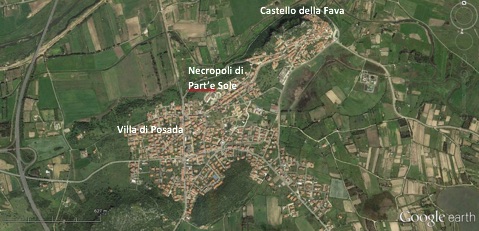Part’e Sole
In Part'e Sole, located west of the Castello della Fava and north of Via Nazionale (figs. 1-2), a necropolis was identified in the 1980s dating back from the early Middle Ages to the XVI - early XVII centuries. Two main structures were unearthed within the area investigated: the first, characterised by an apse-shaped wall, has been interpreted as an ecclesiastical building, the second as a baptistery, because of the presence of a cruciform structure (fig. 3). It has been hypothesised that the church could be identified with the building of Santo Stefano of Posada mentioned in fourteenth century sources.



(from D’ORIANO et alii 1989, fig. 41).
The excavation of the necropolis of Part'e Sun produced extensive information concerning the use of the area during the centuries. The grave goods found belonged to the Middle Ages and consisted of the deceased’s personal items in silver and glass paste and of bronze objects of various kinds. Other materials found in the excavations were commonly used artefacts in iron and other accessories related to clothing, such as buttons or buckles (figs. 4-7).
The discovery of fragments of pottery and a coin proves that the site could have been inhabited in Roman Times.






Bibliografia
- V. ANGIUS, Posada, in G. CASALIS, Dizionario geografico storico-statistico-commerciale degli Stati di S.M. il re di Sardegna, XV, Torino 1847, pp. 672-691.
- M. CADINU, Il progetto della città nella Sardegna medievale, in G. MURA, A. SANNA, Paesi e Città della Sardegna. II. Le città. Cagliari 1999, pp. 91-101.
- M. CADINU, Urbanistica medievale in Sardegna, Roma 2001.
- R. CARTA RASPI, Castelli medioevali di Sardegna, Cagliari 1933.
- A. CASTELLACCIO, Note sul castello de La Fava di Posada, in Medioevo. Saggi e rassegne, 15, pp. 55-84.
- A. DELLA MARMORA, Itinéraire de l’île de Sardaigne, II, Turin 1860.
R. D’ORIANO, Posada (Nuoro): necropoli medievale nel centro dell’abitato, in Nuovo Bullettino Archeologico Sardo, 1, pp. 382-383. - R. D’ORIANO, Posada. Località Parte Sole, necropoli medievale, in Il Suburbio delle città in Sardegna: persistenze e trasformazioni. Atti del III convegno di studio sull’archeologia tardoromana e altomedievale in Sardegna (Cuglieri, 28-29 Giugno1986). Mediterraneo tardoantico e medioevale. Scavi e ricerche 7, Taranto 1989, pp. 51-58.
- G. FLORIS, Il castello medioevale della Fava (Posada), in Acta historica et archaeologica mediaevalia, 29, pp. 257-297.
- F. FOIS, Castelli della Sardegna medievale, Milano 1992.
- L. OGGIANU, La Baronia di Posada. Parte prima. Periodo anteriore alla costituzione della Baronia (1431). Archivio Storico Sardo XII, pp. 3-23.
- A. SANCIU, Posada. Centro storico. Recupero di materiali archeologici, in Erentzias. Rivista della Soprintendenza per i Beni Archeologici per le province di Sassari e Nuoro, I, pp. 376-377.
- C. ZEDDA, Le città della Gallura Medioevale. Commercio, società e istituzioni. Ricerche storiche 4, Cagliari 2003.
G. ZIROTTU, Posada. Un borgo sardo e il suo castello, Nuoro 1999.

 VR
VR